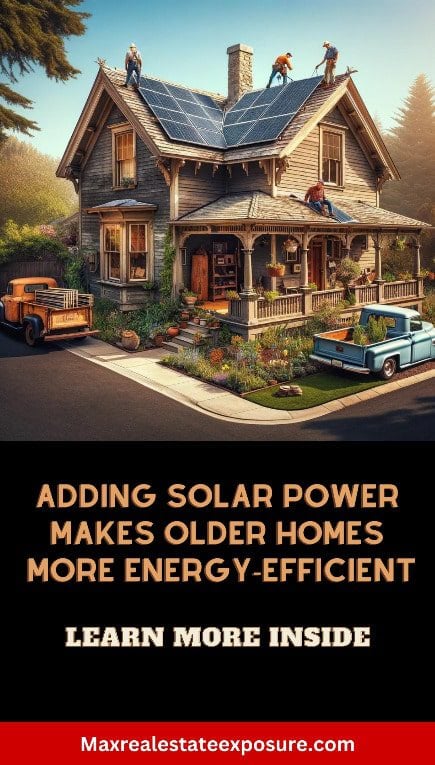How to Make Your Home More Energy-Efficient
 One of the questions people often ask is how to make their homes more energy efficient. This is undoubtedly the case with older homes.
One of the questions people often ask is how to make their homes more energy efficient. This is undoubtedly the case with older homes.
Buying an older home allows you to live in a property with history and charm. However, it also brings its share of extra expenses, particularly regarding energy usage.
Older homes aren’t as energy efficient as newer ones, at least for modern heating and cooling systems.
It only makes sense for the owners of older homes to increase their properties’ energy efficiency. The best energy-efficient upgrades for an older home are the ones that save you the most money!
You can also learn about other great tips on saving energy around your home, especially in the winter. Many of these upgrades and improvements don’t necessarily require you to spend a lot of money, either!
Keep reading, and you will learn more about energy efficiency. First-time sellers should know that buyers love to see energy-efficient upgrades.
Understanding How Older Homes Were Designed
Before we start listing the improvements you can make to your older home, it is worth remembering that many older homes were built to be quite efficient at keeping owners cool in the summer and warm in the winter.
They were constructed before air conditioning or central heat was available, so they had to offer the owners some control over internal temperatures.
You can use these features if you own a home with them.
Older homes often have thicker walls, vents to control airflow, windows and shutters to control airflow and sunlight, porches and awnings for warmer months, and light-reflecting finishes.
They may also have trees strategically placed to shade the home in the summer and drop their leaves to allow sunlight in winter.
When upgrading your older home for energy efficiency, you can approach the improvement process by considering the whole house.
You can improve the existing features using the technology available today.
Improvements For Energy Efficiency
It would help to remember how to get the best return on investment when making home energy efficiency upgrades. Going for the things that will give you the biggest bang for your buck is the wisest choice.
Besides energy efficiency, people often ask what improvements increase a home’s value. Many things can be done, especially in older houses that have not been updated.
Here are some of the best ways to increase your older home’s energy efficiency, including:
Get An Energy Audit
 It would be best to get an energy audit before buying the latest and greatest energy-efficient upgrades. Many municipalities and power companies offer energy audits for free, and even if there is a cost, it is well worth it.
It would be best to get an energy audit before buying the latest and greatest energy-efficient upgrades. Many municipalities and power companies offer energy audits for free, and even if there is a cost, it is well worth it.
If you want the most comprehensive audit, you are probably better off hiring a professional company that charges for their services.
Avoid companies that sell products, such as energy-efficient windows, if you want the most accurate home assessment.
When you request an energy audit, an auditor will come through your home and identify all the areas where you can improve your energy efficiency.
One area they will examine is how well your house seals. The auditor will provide a report showing you different places and options you can take to improve your older home.
Here in Massachusetts, there is a program called Mass Save. It is a fantastic program that allows homeowners to have an energy audit done on their home.
In conjunction with that, they will make a whole host of improvements to the home and cover 75% of the cost! Yes, you read that correctly.
Mass Save will make many improvements to your home that will help save you money, and it will foot most of the bill. A few years ago, I did this to my home in Hopkinton, Massachusetts. I saved significant money on my utility bills from making the improvements.
If you live in another area of the country, I highly recommend checking for programs like this one. You could save a lot of money, especially if you own an older home.
Seal, Seal, Seal
Before the air in homes was conditioned using air conditioners and heaters, having a perfectly sealed home was not a priority. Creating a seal would have been impossible if the house was old enough.
But modern technology allows homeowners to do a surprisingly good job of sealing their homes and air systems to ensure maximum efficiency. The better sealed the house, the less conditioned air will escape and energy wasted.
You can seal your air ducts, doors, windows, foundation, attic, pipe inlets, etc. A reputable contractor can help you seal up every point in your home where air can escape and cause heat or cooling loss.
This will undoubtedly be one of the best energy-efficient upgrades you can make for your money in an older home. HGTV has an excellent guide explaining how to seal a drafty house. In the article, they show how one homeowner shaved a ton of money off his energy bills by sealing the walls in his home.
Insulate Your Home Better
Insulation is another area where most older homes fall short. There were not as many insulating options when older homes were built, so your home could use an upgrade.
A professional can determine exactly how much insulation you need to maximize your home’s efficiency while allowing the house to ventilate. The amount of insulation used will depend on the construction of your home and the climate in your area.
Insulating walls is one of the best ways to increase the energy efficiency of an older home. Many older homes have inferior insulation in the walls or even none at all. Look at the excellent information from This Old House on improving your home.
This is not to say that insulating your attic well isn’t essential. Not only can you save money by having a well-insulated attic, but you will also be putting yourself in a better position to prevent ice dams, which can be a major headache in cold weather climates.
Upgrade Your HVAC System
 Your older home may have an installed heating and air conditioning system. Still, unless it was purchased in the last five years or so, you are likely missing out on newer energy efficiency developments.
Your older home may have an installed heating and air conditioning system. Still, unless it was purchased in the last five years or so, you are likely missing out on newer energy efficiency developments.
HVAC manufacturers are constantly trying to outdo themselves now that energy efficiency has become a desirable selling point, meaning newer HVAC systems are better than older ones.
On average, an HVAC system is expected to have a life expectancy of about 20 years. If your current system is near that age, you should start shopping for a new, energy-efficient option.
An upgrade in your heating and cooling system will save you money over the years by making your bills less expensive.
How Much Will You Save?
Upgrading your HVAC system in an older home can lead to significant savings on your energy bills.
According to Energy Star, installing energy-efficient heating and cooling equipment that has earned the Energy Star label can save up to 20 percent on heating and cooling costs.
This is because newer HVAC units are designed to be more efficient than older ones. They utilize less energy to maintain comfortable house temperatures.
The savings you can achieve by upgrading your HVAC system can vary depending on several factors, including the size of your home, the climate you live in, and your local energy rates.
While national averages can provide a general idea, the savings can differ based on your situation.
For example, a well-insulated home in a milder climate will likely see different energy costs and potential savings than a less insulated home in a harsher climate. Additionally, the type of energy your system uses (gas, electric, etc.) and changes in energy prices can also impact your savings.
An important aspect to consider is the efficiency of the new HVAC system. Energy Star-qualified furnaces are 15% more efficient than conventional models, and Energy Star-qualified boilers are 5% more efficient than new standard models.
These efficiency improvements can reduce your energy consumption and, consequently, your utility bills.
While the upfront cost of replacing an HVAC system might seem high, the long-term savings on utility bills and the increased comfort in your home can make it a worthwhile investment.
To estimate your potential savings more accurately, it is recommended that you use online calculators from reputable sources like Lennox or Energy Star. It would also help to consider your home’s specific characteristics and energy use habits.
Upgrade Your Water Heater
According to Consumer Reports and other reputable sources, a water heater can be nearly 20 percent of a home’s yearly energy costs.
Given the new efficiency standards, water heaters under 55 gallons will see about a 4 percent boost in efficiency.
Water heaters over 55 gallons could cut your utility bills by 25 to 50 percent, depending on the technology used.
Consumer Reports has an excellent guide for buying an energy-efficient water heater. They also explain the different water heaters that can be purchased very well.
Add A Programmable Thermostat
Even if your home is not very old, you may still have an old-school thermostat that offers you very little control over your home’s temperature.
Adding a programmable thermostat will allow you to change the temperature in the home when it needs to be, such as when you go to bed or when you are at work.
There are limits to how much you can alter the temperature without causing extra energy use from your furnace. However, regularly changing the temperature a few degrees can make a noticeable difference in your monthly energy bill.
Some people, however, make the mistake of drastically changing from their average temperature while in the house to something much different when they are not.
For example, if you usually have your home set to 72 degrees because you like a warm house, do not drop the setting to something less than 68 when you are not home. Why, you wonder? When your home’s temperature is set at a certain amount, the furniture and walls are also near that same condition.
When the temperature swings dramatically, it takes far more energy to restore the home and its contents to their usual comfort level.
How Much Will You Save?
Installing a smart thermostat in an older home can lead to notable savings on heating and cooling costs by optimizing energy usage based on your habits and preferences.
According to studies and data from various sources, an Energy Star smart thermostat can save approximately 10–12% on heating and 15% on cooling costs. Depending on your current expenditures for heating and cooling, installing a smart thermostat could save you hundreds of dollars each year.
The efficiency of smart thermostats comes from their ability to learn your routine and adjust the temperature accordingly, ensuring energy is not wasted heating or cooling your home when it’s not needed.
Features like geofencing, remote sensors, and the ability to control your thermostat remotely via a smartphone app contribute to these savings by maintaining optimal comfort levels only when necessary.
Additionally, some utility companies offer rebates or incentives for smart thermostat installation, which can further increase your savings.
Case Studies Back Up These Claims
A case study from TheSmartCave highlighted the potential for energy savings using smart thermostats’ features like nighttime and daytime setbacks. The technology adjusts the temperature when you’re asleep or away from home.
While the study pointed out minimal savings from avoiding morning reheating or using remote sensors alone, the overall conclusion was that smart thermostats could provide comfort and energy savings. This is especially true when combined with intelligent features and scheduling.
Ultimately, the amount of money saved will depend on your specific home, your energy usage habits, and how well you utilize the intelligent features of the thermostat.
Nonetheless, the potential for significant savings and the added convenience and comfort of a smart thermostat makes it a worthwhile investment for many homeowners.
What About Windows?
This one may surprise you, but replacing older windows is not one of the best investments you can make unless you plan on being in your home for a very long time.
While a decent amount of money leaves your home via drafty old windows, it is not close to the money you will spend on replacing them. High-quality replacement windows are costly.
It will take many years for you to re-capture the cost of what you spend on new windows vs the energy savings you will realize.
If you replace your windows, do it because of aesthetics, easy operation, ease of cleaning (tilt-in), and potential improved resale value somewhere down the road. If you think you will be potentially selling your home shortly, replacing the windows does not make a lot of sense in most cases.
Other home improvement projects offer low return on investment. Stay away from these kinds of projects if you don’t want to lose money when potentially selling a home.
I often recommend what not to fix when selling a house. The advice boils down to return on investment. Putting money into a home when selling doesn’t make sense unless it improves its return or saleability.
Seal Your Existing Windows Instead
However, you can do things with your windows to save energy.
Old homes often have drafty doors and windows, which significantly impact comfort. Sealing air leaks or replacing doors and windows can dramatically improve comfort.
Air leaks, usually resulting from cracks or gaps around windows and doors, allow warm air to escape outside. It leads to inefficiency and increased heating costs.
Sealing leaks around doors and windows with caulk, weatherstripping, or putty is crucial. This improvement can save you around 20 percent on heating and cooling costs, as suggested by Energy Star.
Additionally, gaps may be noticed, causing air leakage, visible damage or rot on the frames, condensation between panes, or difficulty opening and closing. It may be worth considering replacing older doors and windows with new ones. Vintage lookalikes can help you maintain the aesthetic of your home.
Install Solar Power
 Solar power is one of the best ways to make any home more energy-efficient. Although adding solar energy is expensive upfront, the longer you stay in your home, the more money you’ll save.
Solar power is one of the best ways to make any home more energy-efficient. Although adding solar energy is expensive upfront, the longer you stay in your home, the more money you’ll save.
Adding solar panels to your home can lead to substantial savings on your energy bills. However, the exact amount you’ll save varies based on several factors, including your location, the size of the solar panel system, your current energy usage, and the cost of electricity in your area.
According to EnergySage, the average homeowner can expect to save between $20,000 and $96,000 over the lifetime of their solar panel system.
SolarReviews notes that, on average, a homeowner in the United States can save about $1,785 per year by switching to solar. This translates to nearly $150 per month in energy cost savings.
The initial cost of installing solar panels can be significant. Average installation costs between $15,000 and $25,000, depending on factors like the size of your home and the quality of the equipment. However, federal tax credits and possibly state incentives can significantly reduce the upfront cost.
You’ll Get Tax Assistance For Making This Improvement
For instance, the federal solar tax credit allows you to deduct 30% of the cost of installing a solar energy system from your federal taxes.
It’s also important to remember that the efficiency of solar panels can degrade slightly over time, generally by 0.1% to 1% per year, which could impact long-term savings.
Nonetheless, a well-maintained solar panel system can last up to 30 years. It provides long-term savings and environmental benefits by reducing reliance on traditional energy sources and decreasing your carbon footprint.
Adding solar panels to your home can be a worthwhile investment. It’s not only for the potential savings but also for the environmental benefits.
The exact savings will depend on your specific circumstances. However, the long-term benefits of solar energy are clear for many homeowners. Please remember if you plan on selling soon, solar panels may not increase your value as much as you paid.
Upgrade Your Electrical System
One aspect often overlooked when renovating a home for energy efficiency is the electrical system, which is a crucial element of any household.
As a real estate agent, I have gone into numerous homes that still have fuse boxes vs an upgraded panel with circuit breakers. I have also been in homes with antiquated systems such as knob and tube and Romex wiring.
Older homes often have outdated electrical systems that cannot support modern appliances and energy demands. This leads to increased risks of electrical fires and shorts.
Therefore, it is advisable to consider replacing the electric panel/breaker box for improved safety and sustainability.
Buy Energy Star Appliances
Upgrading older appliances with Energy Star-rated, energy-efficient models can enhance the sustainability of an older residence. The Energy Star program offers a variety of appliance options. These options include induction cooktops, stoves, clothes washers and dryers, dishwashers, air purifiers, dehumidifiers, freezers, and refrigerators.
It’s important to note that opting for a more efficient model can lead to significant energy savings. For instance, heat pump dryers consume approximately 30 percent less energy than conventional ones.
Upgrading to ENERGY STAR appliances can lead to significant yearly savings on utility bills. The amount you can save varies depending on the type of appliance and its usage.
For example, replacing older, less efficient appliances with ENERGY STAR-certified models can result in considerable savings over time.
Examples of How Much Money Can Be Saved
Specific savings for various appliances are detailed below:
- Clothes Washers: According to Direct Energy, you could save about $40 annually with ENERGY STAR compared to non-certified models. This leads to $415 in savings over an 11-year lifespan.
- Refrigerators and Freezers: Replacing an old fridge or freezer with an ENERGY STAR-certified model can save you $150 to $1,100 on energy costs over the appliance’s lifetime
- Water Heaters: Upgrading to an ENERGY STAR-certified high-efficiency water heater can reduce energy use by 70%, which translates to savings of over $300 annually.
- General Savings: By engaging in Home Performance with ENERGY STAR, focusing on a whole-house approach to improvements, homeowners can save as much as 20% of their utility bill.
It’s also important to consider that many states and local utilities offer incentives, rebates, and tax credits for energy efficiency improvements in addition to these savings. These incentives can further enhance the financial benefits of upgrading ENERGY STAR appliances.
Consider the ENERGY STAR Home Upgrade to maximize savings and efficiency. It emphasizes six high-impact improvements designed to work together to achieve significant energy and cost savings.
These improvements include clean heating and cooling, super-efficient water heaters, smart thermostats, well-insulated and sealed attics, high-performing windows or storm windows, and making your home electric-ready
Ultimately, the potential yearly savings from upgrading to ENERGY STAR appliances, combined with the available incentives, make it a financially sound decision that benefits your wallet and the environment.
Increasing Your Comfort And Satisfaction With Upgrades
The upgrades listed here vary in cost, and you will see the overall difference in energy usage. However, all of them are proven ways to make at least some improvement.
Beyond the benefits of a lower utility bill and being kinder to the environment, increasing energy efficiency will give you more comfort and enjoyment in your home. Any change you can make in this direction is worth the initial costs.
Use these tips to wisely create an older home with more energy efficiency!
Conclusion
You can make many improvements to improve your property’s energy efficiency. As you can afford to make upgrades, it will be wise. The more you can do, the better off you’ll be in the long run.
About the Author: The above Real Estate information on making an older home more energy efficient was provided by Bill Gassett, a Nationally recognized leader in his field. Bill has expertise in mortgages, financing, moving, home improvement, and general real estate.
Learn more about Bill Gassett and the publications in which he has been featured. Bill can be reached via email at billgassett@remaxexec.com or by phone at 508-625-0191. Bill has helped people move in and out of Metrowest towns for the last 38+ years.
Are you thinking of selling your home? I am passionate about real estate and love sharing my marketing expertise!
I service Real Estate Sales in the following Metrowest MA towns: Ashland, Bellingham, Douglas, Framingham, Franklin, Grafton, Holliston, Hopkinton, Hopedale, Medway, Mendon, Milford, Millbury, Millville, Natick, Northborough, Northbridge, Shrewsbury, Southborough, Sutton, Wayland, Westborough, Whitinsville, Worcester, Upton, and Uxbridge Massachusetts.

